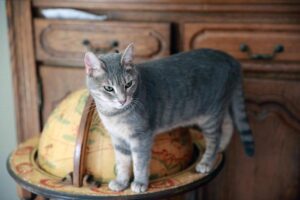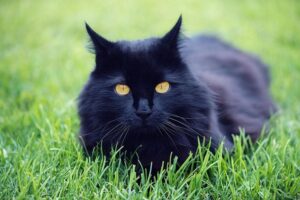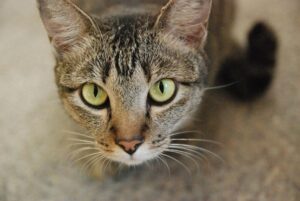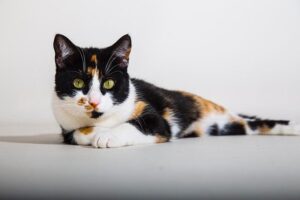Cats, with their big, round eyes and soft paws, are known for their whimsical and curious nature.
They have enchanted the hearts of many people throughout history, captivating numerous historical figures.
This time, we will introduce cats in Japanese history, historical figures who adored cats, and the story of Takeshi, a male calico cat known only to true cat lovers.
Contents
1. When did cats come to Japan?
2. The black cat loved by Emperor Uda
3. The genius ukiyo-e artist, Utagawa Kuniyoshi, and cats
4. The story of Takeshi, the calico cat guardian of the Antarctic observation ship Soya
Summary
1. When did cats come to Japan?

It is said that people began living with cats 10,000 years ago in Mesopotamia.
But when did cats arrive in Japan?
The first cats arrived in Japan around the Nara to early Heian period.
Approximately 1200 to 1300 years ago, it is believed they were brought over from China along with Buddhist scriptures on ships to protect the scrolls from mice.
However, in 2007, a Sue ware (a type of pottery made from the middle Kofun to Heian period) with cat paw prints was found at the Minoo Kofun site in Himeji City, Hyogo Prefecture.
This discovery suggests that cats had been in Japan at least 1400 years ago, during the late Asuka period, earlier than previously thought.
Further discoveries continue.
In 2008, several cat bones were found at the Karakami archaeological site on Iki Island, Nagasaki Prefecture, along with bones of fish, snakes, wild boars, and deer.
These bones were determined to be from the Yayoi period, about 2100 years ago, suggesting that cats may have been in Japan around the same time or even earlier than they appeared in China.
This raises the possibility that cats may have been introduced to Japan from routes other than China.
Therefore, the exact origins and the way cats came to Japan are still not fully understood and may remain a mystery forever.
2. The black cat loved by Emperor Uda

Although the exact time when cat arrived to Japan is unknown, the oldest recorded pet cat is from the Heian period, appearing in the "Kanpyo Gyoki" (Emperor Uda's diary) written by Emperor Uda during his reign from 887 to 897.
This diary is famous as the oldest existing record of a pet cat, written by an actual person, and often discussed for the emperor's adoration for cats.
The cat was a gift from Minamoto no Kuwashi, the Dazai Daini, to Emperor Koko (Emperor Uda's father) and was later given to Emperor Uda before his ascension to the throne.
Emperor Uda cherished the cat he inherited from his father, and his diary contains many descriptions related to the cat.
For example, he noted the unique beauty of his cat's jet-black fur compared to the lighter shades of other cats and likened its lying posture to a precious gem and its movement to a dragon above the clouds, showing a cultured way of expression.
However, he also praised its ability to catch mice faster than other cats, indicating a deep affection for his pet.
As these writings were made by an emperor, they were guaranteed to be preserved for posterity, revealing the emperor's detailed accounts of his cat, highlighting his extreme fondness for cats.
Moreover, he even wrote, "I cherish this cat not because it is exceptional but because it was bestowed by the previous emperor," which sounds somewhat like an excuse.
3. The genius ukiyo-e artist, Utagawa Kuniyoshi, and cats

Utagawa Kuniyoshi, a leading genius ukiyo-e artist of the late Edo period, was celebrated for his rich imagination, innovative ideas, and unparalleled drawing skills.
Kuniyoshi, known for his numerous works featuring cats, also left behind many anecdotes as a cat lover.
He reportedly kept several cats, sometimes up to dozens, and it is said he even worked with cats in his lap.
Possibly, he might have used cats as an excuse for missing deadlines, saying, "I couldn't draw because the cat in my lap wouldn't stay still."
Imagining his disciples, frustrated with Kuniyoshi's procrastination due to his cats, suggesting, "Master, why not paint cats?" is an amusing thought.
Nevertheless, Kuniyoshi produced numerous works featuring cats.
He created "Sonoma Jiguchi Nyokai Koko Gojusan Hiki" by punning on the names of the fifty-three stations of the Tokaido with cat poses, starting with works like "Goldfish Extravaganza Hyaku Monogatari," "Cat's Training," and "Fashionable Cat Teasers." Kuniyoshi's cat illustrations were even believed to ward off mice, sparking a cat craze in Edo.
According to one of his disciples, Utagawa Yoshihide, Kuniyoshi's cats were buried at the Eko-in temple after they passed away.
There was a Buddhist altar for cats in Kuniyoshi's house, complete with memorial tablets with their posthumous Buddhist names.
Kuniyoshi's deep affection for cats is evident from his continuous observation and depiction of them.
4. The story of Takeshi, the calico cat guardian of the Antarctic observation ship Soya

On November 8, 1956, a cat set sail from Tokyo's Harumi Wharf with 53 observation team members, 22 Karafuto dogs, and 2 canaries.
The ship's name was Soya, Japan's first Antarctic observation vessel.
The 2-month-old kitten, a rare male calico, was gifted by an animal welfare organization, hoping for the ship's safe voyage.
Male calico cats are extremely rare, with a birth rate of only about 1 in 30,000, considered to bring good luck, hence chosen as Soya's talisman.
Named Takeshi after the expedition leader, Takeshi Nagata, the cat was purely loved as a pet by the crew members.
On January 29, 1957, the observation team officially landed on the Antarctic continent and established Showa Station. Soya departed for Japan on February 15, but Takeshi was left behind at the crew's strong request to stay for the winter.
Originally boarded as a talisman, Takeshi had no involvement in research or cargo transport at Showa Station, purely adored as a pet.
He patrolled the area around Showa Station as his territory, always relieving himself outdoors even on cold days.
However, Takeshi, who was enjoying his leisurely Antarctic life as the station's mascot, encountered a major accident in October 1957, shortly after his first birthday.
Whether seeking warmth or for another reason, he crawled inside a large communication device and touched a high-voltage line.
Discovered by crew members alerted by the loud noise, Takeshi was rescued but fell unconscious for a time.
Thanks to the crew's dedicated care, Takeshi recovered in just a few days.
One might think it's because he was a male calico, but the joy of the crew members is easy to imagine.
As the end of the Antarctic stay approached, the time to switch with the second wintering team neared.
However, bad weather prevented Soya from docking, and the Showa Station crew had to fly to Soya on a small plane.
Subsequently, the weather did not improve, leaving both the awaiting second wintering team and Soya to depart from Antarctica.
The dogs left for the second team remained, including Taro and Jiro, who were also close to Takeshi.
On April 28, 1958, Soya docked at Sunrise Pier, marking its return to Japan.
After returning, Takeshi was taken in by a communications crew member he was particularly close to, Mr. Sakuma.
However, about a week later, Takeshi suddenly disappeared from Mr. Sakuma's home.
Perhaps he yearned to return to his territory in Antarctica.
Mr. Sakuma thought so, too, believing Takeshi's soul had gone to Showa Station and vowed to join him in spirit after his own death, planning to say, "I've been searching and waiting for you," upon their reunion.
Summary
Currently, it's not clear when cats first arrived in Japan.
The oldest traces date back 2100 years to the Yayoi period, with cat bones found at the Karakami site indicating they were kept as pets.
The earliest recorded pet cat exists from the Heian period, documented by Emperor Uda in "Kanpyo Gyoki," sparking the first cat boom among the nobility.
By the Edo period, cats were valued for their role in exterminating rats that ravaged crops, becoming integrated into people's lives through ukiyo-e and other forms.
As cat ownership became more common among the populace towards the end of the Edo period, a significant cat boom occurred.
While Taro and Jiro's survival story may overshadow his contributions, Takeshi, the male calico cat of Soya and Showa Station, left his mark on Japanese history, cherished and adored by the Antarctic observation team.
Cats have always captivated and accompanied humans, regardless of the era.


